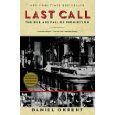
I am not a big fan of military history, but I needed to read about World War I as it seemed to be glossed over in the shadow of World War II in history classes. It almost seems reduced to trivia answers: the Archduke Ferdinand, trench warfare, doughboys, the Red Baron, Treaty of Versailles. Maybe the fact that the US was late to enter the war and it was relatively brief and less painful than the Europeans' experience that it is almost overlooked in US history studies. Go to any large bookstore (while you can) and peruse the history and military aisles. There are rows and rows of Civil War and WWII books. Entire sections. And nestled in between you will probably find the obligatory account of the Spanish American War (most likely focusing on Teddy Roosevelt) and maybe a book or two about the Great War in Europe.
But what was the experience of the United States? Even if it was a short engagement the mobilization was massive compared to the somewhat recent conflict in Cuba. And the country was a very different place than when a previous generation raised arms in the Civil War. How did that happen? That is what I wanted to read about. With no compelling recent books I found The War to End All Wars: The American Military Experience in World War I written in 1968 by Edward Coffman. The book is exactly as advertised in the title. It barely covers the European conflict prior to the American involvement and then focuses exclusively on the planning, mobilization, administration, and finally major battles.
The battle description in the latter part of the book were interesting from the perspective of the decision-making and communications challenges, however it did not capture the true experiences of the thousands that lived and died through the horrors of early modern warfare.
The first half of the book described a mobilization effort that is still almost unbelieveable. The United States had a very, very small standing army and the institutions and infrastructure were basically nonexistent, or relics of the Civil War. That includes people and knowledge. The conscription, training, feeding, clothing, and moving of more than a million men from a standstill is remarkable. Of course many had little to no training. Others used sticks instead of guns for practice until they reached the front. Tanks and airplanes were brand new technology that no one knew how to use and maintain, let alone to understand and coordinate optimal military strategies for them.
The infrastructure created, including the financing and industrial relations, will obviously be key to the country's ability to expand into a world power in the coming century, specifically its lead role in WWII. (Personal shout out to Mr. Bernard Baruch for his leadership in WWI as the most famous alum and namesake of my graduate school!) While the book stopped with the armistice, I want to know more how much the country was truly changed by this experience, how much infrastructure remained versus dismantled, and how the attitude of people changed as the soldiers returned to waving flags and bands with stories of the horror of a great war, all against a backdrop of a rapidly world and their country's position in that world was changing.
Coffman's book is a fine read. 3/5 stars. As mentioned the focus is exclusively on the American experience. While it is not a page turner, it is readable and appears to be thorough, with a good use of primary sources and accounts from multiple perspectives. Written in 1968, there are fleeting references to Vietnam and he anticipates World War II, often hinting at people who would later become prominent in that story.
(Read July 2011)
The battle description in the latter part of the book were interesting from the perspective of the decision-making and communications challenges, however it did not capture the true experiences of the thousands that lived and died through the horrors of early modern warfare.
The first half of the book described a mobilization effort that is still almost unbelieveable. The United States had a very, very small standing army and the institutions and infrastructure were basically nonexistent, or relics of the Civil War. That includes people and knowledge. The conscription, training, feeding, clothing, and moving of more than a million men from a standstill is remarkable. Of course many had little to no training. Others used sticks instead of guns for practice until they reached the front. Tanks and airplanes were brand new technology that no one knew how to use and maintain, let alone to understand and coordinate optimal military strategies for them.
The infrastructure created, including the financing and industrial relations, will obviously be key to the country's ability to expand into a world power in the coming century, specifically its lead role in WWII. (Personal shout out to Mr. Bernard Baruch for his leadership in WWI as the most famous alum and namesake of my graduate school!) While the book stopped with the armistice, I want to know more how much the country was truly changed by this experience, how much infrastructure remained versus dismantled, and how the attitude of people changed as the soldiers returned to waving flags and bands with stories of the horror of a great war, all against a backdrop of a rapidly world and their country's position in that world was changing.
Coffman's book is a fine read. 3/5 stars. As mentioned the focus is exclusively on the American experience. While it is not a page turner, it is readable and appears to be thorough, with a good use of primary sources and accounts from multiple perspectives. Written in 1968, there are fleeting references to Vietnam and he anticipates World War II, often hinting at people who would later become prominent in that story.
(Read July 2011)


![Benjamin Harrison: [The American Presidents Series]](http://photo.goodreads.com/books/1172646391s/203410.jpg)



